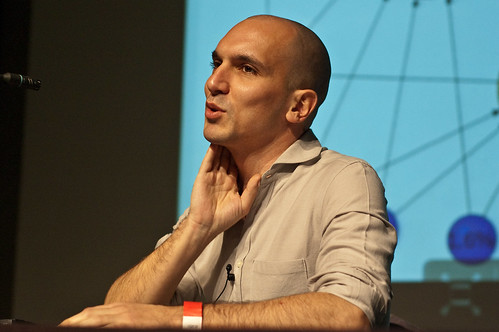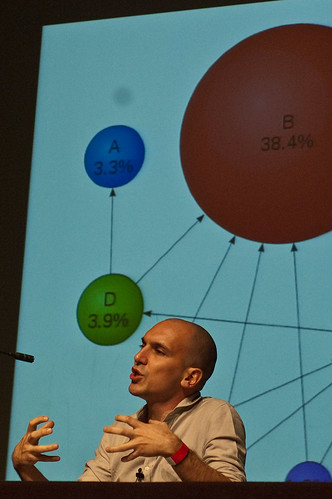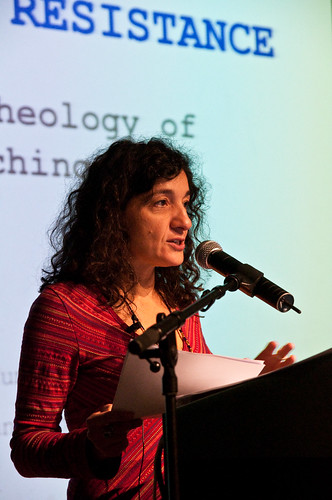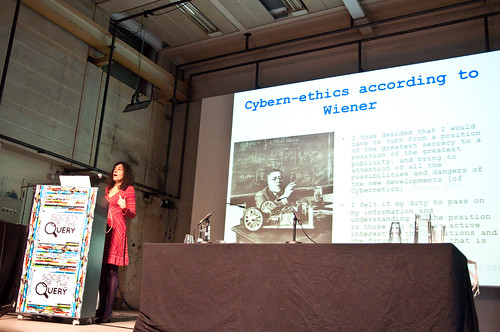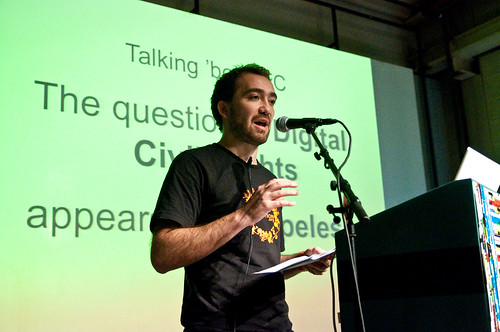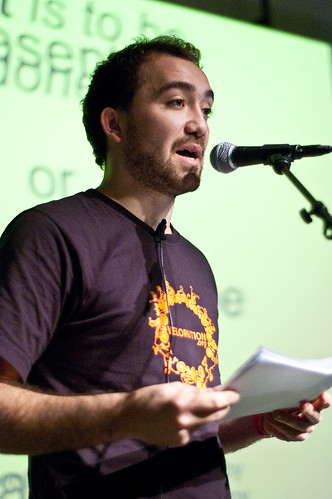In a presentation given yesterday at Picnic for the Bloggers Lab, organized by the European Journalism Centre, Ethan Zuckerman brought up an interesting concept that has quite remotely been discussed over the internet for a while now.
Today we are all enjoying this second step of the web evolution, the web 2.0, a read/write space where we can actively participate and create content by blogging, we can meet individuals that we would otherwise not have access to, by registering in social networks and creating online communities, and where we can use a lot of other interactive tools. The internet thus has the potential to largely expand our informational and relational capacities in a multitude of directions. Nevertheless, humans’ behaviour online seems to disregard the real capacities and potential of the internet. The behaviour of individuals online seems to be following an intrinsically human principle of behaviour that guides our actions in real life, defined by sociologists as homophily. Homophily refers to humans’ tendency to associate and connect with individuals similar to them in certain aspects, people who share their interests, values, culture, who have the same demographical, racial characteristics, etc., which leads to one of the main characteristics of a social network, which is homogeneity. This principle of homophily is the foundation of the most various human relations and networks, from marriage, to friendship, work, information exchange, and others. Homophily, a concept that can be expressed by the saying: birds of a feather flock together, plays an essential role in shaping our individual and collective view of the world. Sociologists acknowledge that “Homophily limits people’s social worlds in a way that has powerful implications for the information they receive, the attitudes they form, and the interactions they experience”.
The same principle is guiding our behaviour online and there are several types of applications that exploit it. One example are online social networks. On Facebook, Hyves, MySpace, etc., individuals connect with other individuals that they know in real life, and with whom they presumably have common interests or other socio-demographical, behavioural, and intrapersonal characteristics, and then with the friends of their friends, and with potential friends that are automatically suggested to them by the application, based on common profile characteristics. Although the web 2.0 does amplify the broadening of our network with people whom it would be unlikely to meet in real life, it is said to also amplify the narrowing of our spectrum of knowledge in other fields, if our actions online are aimed only at reinforcing our own ideas, by, for example, registering in groups that share our interests or subscribing to feeds on a particular subject that we are interested in.
Another type of online application that reflects well homophily, upon which Ethan Zuckerman drew attention in his presentation yesterday, are the media aggregators. Media aggregators are online applications that maintain subscription to feeds of media content coming from various sources: blogs, vlogs, etc. The content of these media aggregators is determined most of the times by user votes. It would not be surprising, if we were to analyze the profile of the users that are involved in the voting systems, that their profile is similar to ours, individuals who subscribe to feeds through these websites. And Zuckerman draws attention on this aspect in one of his interviews by raising a question: “If you look at sites like Digg and Reddit, these are sites that promised the future of journalism, where we would all get together and decide what’s important. …But that begs the question: Who’s ‘we?’”. And the answer to this question would be: people who have similar interests to ours. Zuckerman further develops this idea in another one of his declarations: “Cass Sunstein, an amazing legal scholar, says that one of the dangers of the internet is that we’re only hearing like voices, and that makes us more polarized […]. What’s incredible about the net is we have this opportunity to hear more voices than ever. But the tools we tend to build to it have us listening to the same voices again and again.” Zuckerman makes it clear that it is not the internet that is intrinsically wrong, but that individuals tend to use it in limitative ways: searching and selecting information and individuals mainly to reinforce their own ideas: “Encountering new ideas isn’t a supply problem in today’s internet – it’s a demand problem. There’s a near infinity of people unlike you creating content and putting it online for you to encounter. But it’s entirely possible that you’ll never encounter it if you don’t actively look for it… or unless the systems you use to find ideas start forcing you outside your usual orbits into new territories.”
Zuckerman takes a strong position against homophily: “Homophily can make you really, really dumb”. He opposes to the effects of homophily another concept, serendipity: “Search in the future needs to lead us to people, to places, to voices. My hope is that in the future we get over homophily and we start looking for really productive serendipity – the sort of serendipity when you go to that shelf in the library and you think you know the book that you’re looking for, but you actually find the book you’re really looking for within 2-3 shelves of it. You think you’re looking for info on the US elections, but you end up finding info on how the Jamaicans are viewing the US elections. You think you’re looking for info on network security and you end up finding information on why Pakistan is so afraid of YouTube.”
On the other hand, homophily is seen as a good aspect by communication theorists from certain points of view because it facilitates communication. It eliminates communication barriers coming from various types of differences between individuals, that lead to misunderstandings or distortion of messages. It leads to effective communication, effective collaborations between individuals and collaborative development of ideas. The downside of homophily derives from the fact that, although we efficiently and “comfortably” communicate with like minded individuals, we have the tendency to avoid contacts that take us out of our “comfort” zone, which can be a field that we are not in control of, have few information about, or are unaware of: “We know so little about one another, and what we do know is generally so wrong, that our first instinct is to try to shut each other off.” Fighting the homophily instinct is an effort that will lead us to the better or full use of technology: “We can’t just assume that being connected [via the net] solves these problems. If you let us work it out on our own, we tend to reinforce our own prejudices and stereotypes. . .”
The tendency towards homophily in the selection of information is a fundamental aspect that individuals that use new media should be aware of, as a first step towards fighting it. But, although indeed some applications of web 2.0 tend to polarize and reinforce our opinions even more, the discussions about homophilous behavior online tend to take a very critical position and leave aside the fact that some web 2.0 applications specifically encourage divergence of ideas by allowing unrestricted feedback. Placing a posting on your blog or on a forum brings your ideas into the public sphere and automatically attracts opposite reactions by means of comments for example, pushing you towards expanding your comfort zone.
Ethan Zuckermann is a fellow at the Berkman Center for Internet and Society of the Harvard University, co-founder of Global Voices Online magazine. He is involved in several other projects that focus on the impact of technology on the developing world and the encouragement of bridge blogging (including people in developing nations in global dialogues).
More sources:
Why Internet is Making Me Stupid
Homophily, serendipity, xenophilia
Why Everyone You Know Thinks the Same as You
[1] http://www.ethanzuckerman.com/blog/2007/12/19/social-software-serendipity-and-salad-bars-mmm-sybillance/
[2] http://www.contentious.com/2008/04/20/breaking-out-of-the-echo-chamber/
[3] http://www.contentious.com/2008/04/20/breaking-out-of-the-echo-chamber/
[4] http://www.contentious.com/2008/04/20/breaking-out-of-the-echo-chamber/
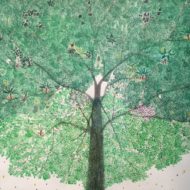



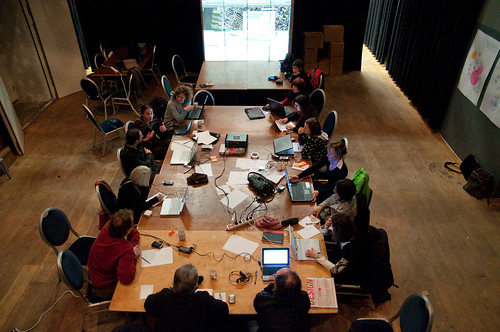



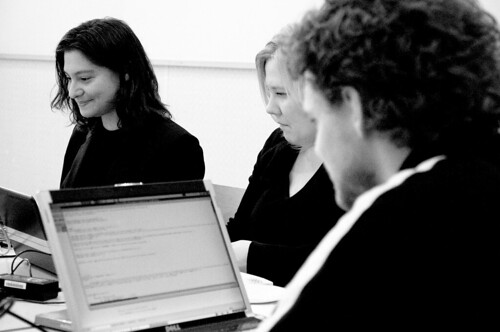
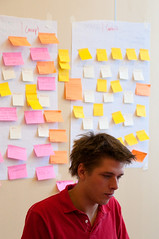

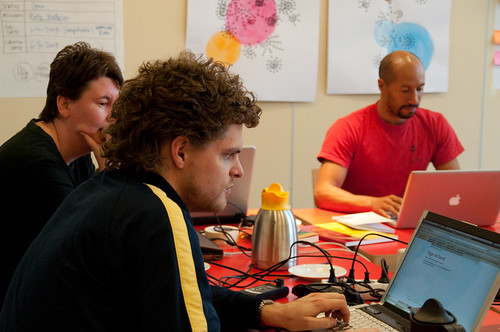
 The Society of the Query
The Society of the Query 